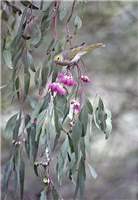Family
Meliphagidae
Genus
Lichenostomus
Species
penicillatus
Threats/Control Methods - Regional
Red River Gums (Eucalyptus camaldulensis) are the preferred habitat species for the White-faced Honeyeater. In the Canberra region, these trees are part of an Endangered Ecological Community due to land clearing, firewood collection and weed and pest invasions. The main areas of potential future conflict between urban land use and woodland conservation are around the Gungahlin area and at Jerrabomberra/Symonston.
Threats/Control Methods - Local
The removal of mature eucalypts from the suburbs will threaten the survival of this species, as will the attacks from free-roaming domestic pets when they feed on the ground.
Local/Urban Actions
Residents are encouraged to help protect the endangered grassy woodlands around the ACT by not collecting firewood, by removing weeds from gardens and by joining in local conservation efforts by community groups such as Landcare. Dog owners should keep their pets on a leash in reserve areas and cat owners can prevent their pets preying on the species by creating a stimulating indoor environment and by installing a cat run or enclosure.
Common Names
White-plumed Honeyeater, Australian Canary, Carter's Honeyeater, Chickowee, Greenie, Linnet, Native Canary, Pallid Honeyeater, Ringeye, Ringneck
Distinguishing Features
The White-plumed Honeyeater is a medium sized honeyeater, 15-17cm in size. Its back and wings are yellowish olive-grey with yellow edging on its tail and a brighter yellow forehead. It has a down curved black beak and a distinctive diagonal white plume lined with black and on the throat. The males are slightly larger than the females and young birds are duller in colour with less distinct plumes.
Survey Techniques
Call and visual identification.
Species Call
A clear in-flight musical call, a peeping alarm, and a 'witch-a-whee, 'witch-a-whee-whit' call.
Similar Species
The plume on this species is very distinct and does not look similar to any of the other honeyeater found in the Canberra region.
Distribution
The White-plumed Honeyeater is found right across the Australian mainland, excluding the tropical areas of northern Australia and the very arid central regions.
Country of Origin
Australia.
Conservation (Pet/Pest) Status - Regional
The population numbers have fluctuated but overall remain stable (COG).
Conservation (Pet/Pest) Status - National
Secure, not listed under the EPBC Act 1999.
LSCCES Population
Moderate values were recorded in the NMA precinct, Black Mountain Peninsula and small areas of appropriate habitat in Civic West (West Basin) ANBG and ANU Campus.
Associated vegetation community
This species favours grassy woodland areas and dry open forests, often near water.
Limiting Resources
White-plumed Honeyeaters seem to require tall, mature eucalyptus trees. In particular, there seems to be a link between red river gums (Eucalyptus camaldulensis) and the distribution of this species. They are also only found where water is easily accessible.
Breeding
The female weaves a grass and spider web nest on a tree branch and lays 2-3 eggs. She incubates the eggs for two weeks and both parents share feeding the young for the following two weeks. Most dependant young in the Canberra region are seen in January and February, however breeding can take place at any time throughout the year.
Behaviour
The White-plumed Honeyeater is a noisy bird, usually seen in small groups. The species breeds in the Canberra area, although it tends to be found in higher numbers in the cooler months, when it moves into urban parks and gardens. It can be seen actively feeding in eucalypt trees or darting through the air to catch insects. It will also hop around the base of trees is search of insects and seeds. Breeding males spend their days flying above the treetops singing, before diving into nearby trees.
Functional Group
Food Species
The White-plumed Honeyeater feeds from leaves and flowers in the thick tops of trees and in shrubs. Its main foods are nectar, fruit, insects, insect products like lerps and honeydew, tree sap (manna) and some seeds. It will also feed from the ground.
Predators
Various birds of prey and Kookaburras (Dacelo novaeguineae ) are known to attack this species.
Interesting Fact
The White-plumed Honeyeater is one of the first birds to call in the morning and the last to call in the evening.
References - (reader suitability of references, P=Primary teachers, S=Secondary students, T=Tertiary students and researchers)
Books:Longmore, W. 1991. Honeyeaters and their Allies of Australia. CollinsAngus&Robertson Publishers Australia. NSW. P, S, T
Morcombe, M. 2000. Field Guide to Australian Birds. Steve Parish Publishing. Archerfield. Australia P, S, T
Veerman, P. 2003. Canberra Birds: A report on the first 21 years of the garden bird survey. Philip Veerman and Canberra Ornithologists Group. Canberra. S, T
Internet: Birds in Backyards 2006. [online]. Available at:http://www.birdsinbackyards.net P, S, T
Canberra Ornithological Group (COG). 2004. Birds of Canberra Gardens. COG and the ACT Department of Urban Services. [online]. Available at:http://garden.canberrabirds.org.au/ P, S, T
Online Publications:Environment ACT. 2006. Yellow Box/Red Gum Grassy Woodland (An Endangered Ecological Community). ACTION PLAN No.10. [online]. Available at:http://www.environment.act.gov.au/__data/assets/pdf_file/13428/actionplans10.pdf S, T
Nix, H. and Cunningham, R. 2006. Birds of the Lower Sullivans Creek Catchment, Canberra ACT. Prepared for the Life in the Suburbs project using data from the Lower Sullivans Creek Catchment Ecological Survey (LSCCES). Australian National University. Canberra. [online]. Available at: http://www.lifeinthesuburbs.com.au/category.php?id=65 S, T


 Top
Top Top
Top